If you possess an unwavering passion for equines and are captivated by extraordinary and obscure breeds, then the Spanish horse breeds are an absolute must-explore for you. Spain boasts a captivating equestrian culture and a rich history that has given rise to a multitude of remarkable horse breeds. In the following article, we embark on a journey into the world of Spanish horses, delving into the ten finest breeds hailing from Spain, encompassing both rare and diminutive varieties that deserve notable recognition. So, prepare yourself, and let’s commence this captivating voyage!
1. Andalusian Horse
Color: Various colors, including gray, bay, and black. Size: 15 to 16.2 hands (60 to 65 inches). Weight: Approximately 1,000 to 1,200 kilograms (2,200 to 2,600 pounds). Diet: High-quality forage, supplemented with grain and minerals. Distinguishing Features: Arched neck, well-muscled body, expressive eyes.
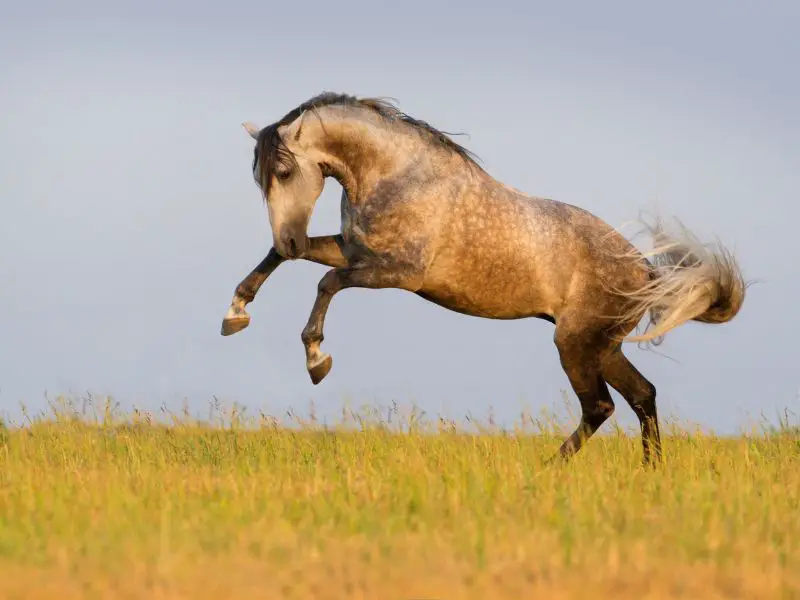
The Andalusian horse holds a prominent position among Spanish horse breeds, boasting a lineage that traces back centuries to the ancient times of the Iberian Peninsula. Renowned for its robust physique, elegant movements, and regal appearance, the Andalusian horse has been a favorite among royalty and nobility throughout history.
The Andalusian horse showcases remarkable versatility, excelling in various equestrian disciplines such as dressage, show jumping, and driving. Its natural talent, willingness to please, and trainable nature make it a remarkable companion. Whether executing intricate dressage movements or effortlessly overcoming challenging obstacles, the Andalusian horse epitomizes elegance and athleticism.
2. Lusitano
Color: Various colors, including bay, gray, and chestnut. Size: 15 to 16.2 hands (60 to 65 inches). Weight: Approximately 1,000 to 1,200 kilograms (2,200 to 2,600 pounds). Diet: High-quality forage, supplemented with grains and vitamins. Distinguishing Features: Well-defined musculature, intelligent expression, strong hindquarters.
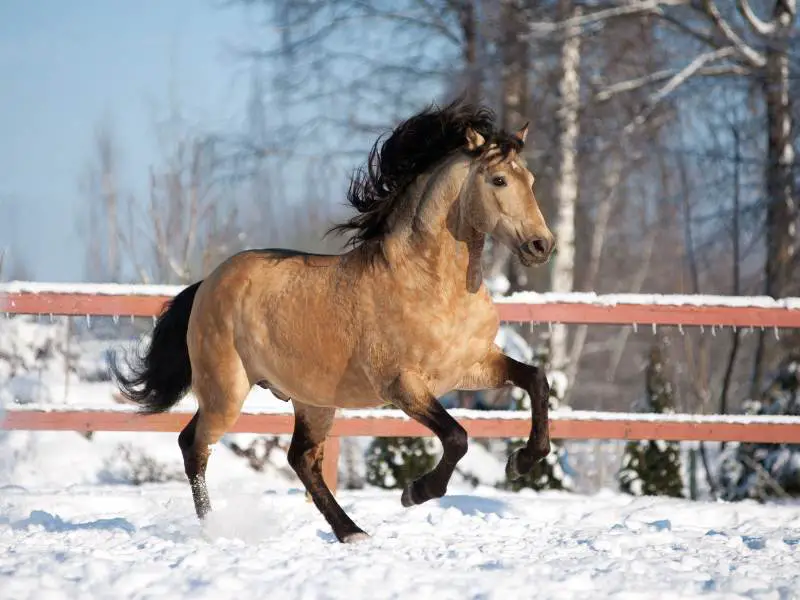
The Lusitano horse, originating from Portugal, shares many similarities with its Spanish counterpart, the Andalusian horse. Admired for its striking beauty, remarkable athleticism, and versatility, the Lusitano breed captivates horse enthusiasts worldwide. With its elegant movements, strong hindquarters, and intelligent demeanor, it exudes a unique charm.
Like the Andalusian, the Lusitano excels in a wide range of disciplines, including dressage, working equitation, and bullfighting. Its compact build, agility, and trainability make it well-suited for demanding activities. Known for its cooperative nature, eagerness to please, and ability to form deep bonds with riders, the Lusitano horse leaves a lasting impression.
3. Menorquín Horse
Color: Primarily black, although other colors can occur. Size: 14.1 to 15.2 hands (57 to 62 inches). Weight: Approximately 400 to 500 kilograms (880 to 1,100 pounds). Diet: High-quality forage, supplemented with grains and vitamins. Distinguishing Features: Compact build, strong legs, high-stepping movements.
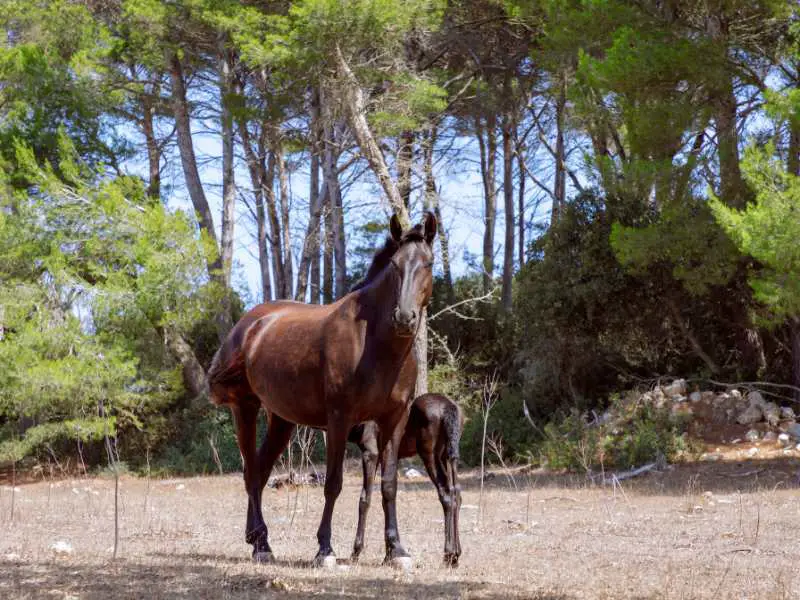
The Menorquín, hailing from the enchanting island of Menorca, represents a small Spanish horse breed that epitomizes strength, endurance, and grace. Deeply woven into the island’s vibrant history and culture, these horses possess distinct characteristics that set them apart. Instantly recognizable by their striking black coats, sturdy builds, and captivating high-stepping movements, Menorquíns leave a lasting impression. Throughout history, people have employed Menorquíns for various tasks, including agricultural work, transportation, and bullfighting. Their agility, resilience, and unwavering determination make them ideal for these demanding activities. Today, they continue to captivate audiences with their elegant presence, remarkable versatility, and gentle temperament. Whether performing traditional dressage movements or participating in captivating equestrian displays, Menorquíns showcase their exceptional qualities.
Related: How to keep a grey horse clean in winter?
4. Asturcón
Color: Bay, chestnut, or black, often with white markings. Size: 11 to 12 hands (44 to 48 inches). Weight: Approximately 250 to 300 kilograms (550 to 660 pounds). Diet: Grazing on mountain pastures with access to supplemental feed. Distinguishing Features: Compact build, thick mane and tail, gentle temperament.
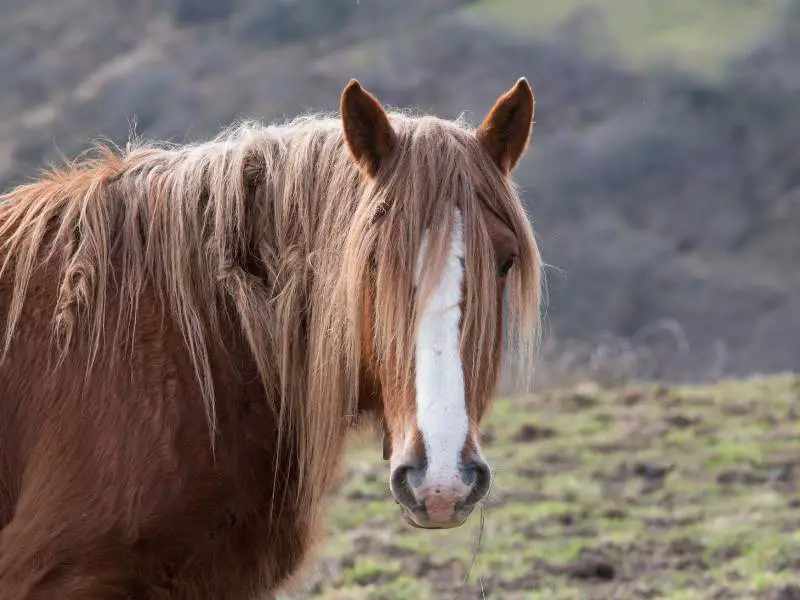
The Asturcón, also known as the Asturian Pony, symbolizes a small Spanish horse breed originating from the rugged mountains of Asturias. These ponies have deeply influenced the region’s culture and traditions throughout the centuries. Despite their small stature, Asturcóns exhibit exceptional strength, agility, and a remarkably gentle temperament.
The challenging mountainous terrain of Asturias has contributed to the development of the Asturcón breed, endowing them with unrivaled surefootedness and adaptability. Renowned for their resilience and ability to navigate treacherous landscapes, these ponies have historically served various purposes, including agricultural work, transportation, and as beloved mounts for children. Their friendly nature and the ability to form deep connections with humans have elevated the Asturcón to the status of a cherished breed.
5. Pottok
Color: Various colors, including bay, black, and gray. Size: 11.2 to 13.2 hands (46 to 54 inches). Weight: Approximately 200 to 250 kilograms (440 to 550 pounds). Diet: Grazing on native grasses, supplemented with hay and grains. Distinguishing Features: Compact build, thick mane and tail, hardy nature.
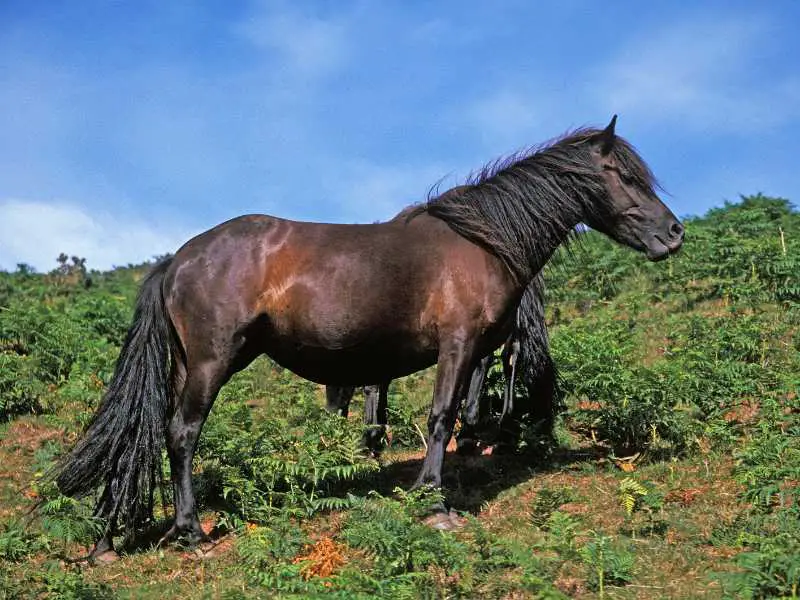
The Pottok, a rare and ancient breed indigenous to the Basque Country in northern Spain, fascinates with its unique characteristics that allow it to thrive in its mountainous habitat. These diminutive horses possess a compact physique, luxuriant manes and tails, and an unwavering spirit of resilience.
Endowed with adaptability and intelligence, Pottoks have traditionally been used for herding, riding, and light agricultural work. They possess a gentle and willing temperament, making them suitable for riders of all ages and skill levels. Increasingly popular as family horses and companion animals, Pottoks captivate with their striking appearance, unwavering resilience, and friendly disposition.
6. Galician Pony
Color: Various colors, including bay, chestnut, and gray. Size: 11 to 13 hands (44 to 52 inches). Weight: Approximately 200 to 300 kilograms (440 to 660 pounds). Diet: Grazing on natural vegetation, supplemented with hay and grains. Distinguishing Features: Sturdy build, thick mane and tail, friendly disposition.
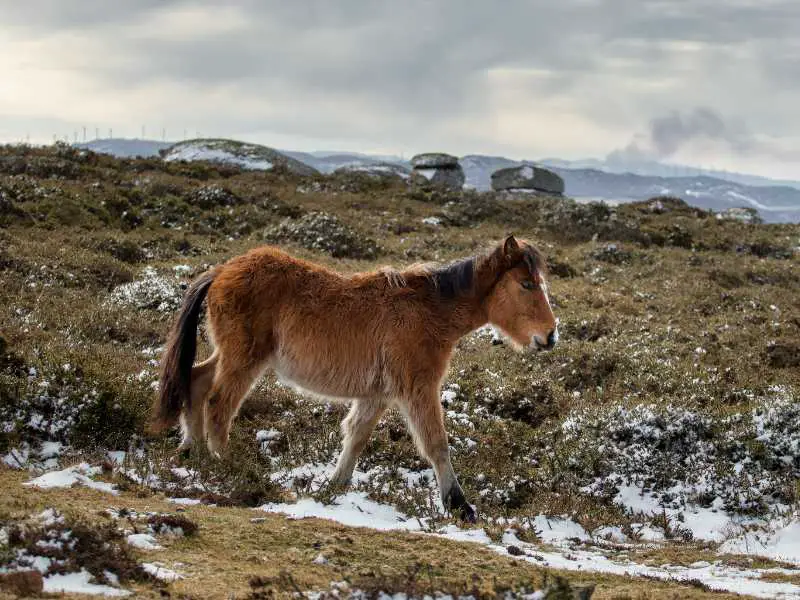
The Galician Pony, or Caballo de Pura Raza Gallega (P.R.G.), represents a small Spanish horse breed originating from the picturesque region of Galicia in northwestern Spain. These ponies have seamlessly adapted to the region’s challenging climate and rugged terrain, leaving an indelible mark on Galicia’s equestrian heritage.
Galician Ponies epitomize resilience, strength, and versatility. Over the years, people have used them for diverse purposes, including agriculture, transportation, and recreational riding. Renowned for their friendly nature, they serve as cherished companions for both children and adults. Their compact size, combined with their robust build and gentle temperament, endear them to equestrian enthusiasts worldwide.
Related: Is Horse a Pet Animal or a Farm Animal Why?
7. Serrano
Color: Bay, chestnut, or gray, often with white markings. Size: 14.2 to 15.2 hands (58 to 62 inches). Weight: Approximately 400 to 500 kilograms (880 to 1,100 pounds). Diet: Grazing on mountain pastures, supplemented with hay and grains. Distinguishing Features: Sturdy build, surefootedness, gentle temperament.
The Serrano, also known as the Mountain Horse, represents a Spanish horse breed that thrives in the mountainous regions of northern Spain. These horses have evolved to conquer challenging terrains and withstand extreme weather conditions. The Serrano breed is esteemed for its strength, surefootedness, and remarkable ability to navigate steep slopes with ease.
Serranos have historically been used for livestock herding, transportation, and various agricultural tasks. Their robust build, enduring stamina, and surefootedness make them perfectly suited for these demanding roles. Possessing a gentle temperament and displaying remarkable versatility, Serranos have gained popularity among riders seeking reliable and resilient companions for recreational riding and endurance events.
8. Burguete Horse
Color: Gray or bay, sometimes with white markings. Size: 15.2 to 16.2 hands (62 to 66 inches). Weight: Approximately 550 to 600 kilograms (1,210 to 1,320 pounds). Diet: High-quality hay, grains, and pasture grazing. Distinguishing Features: Elegant appearance, docile temperament, strong build.
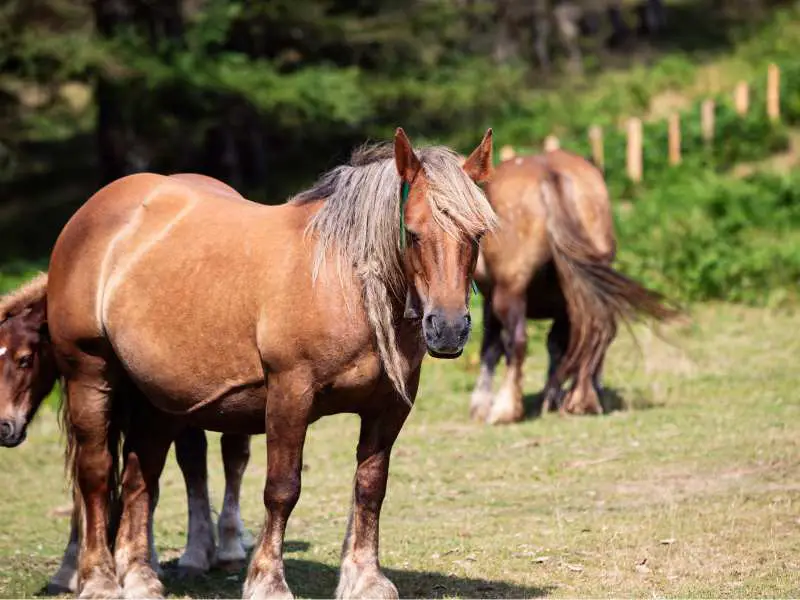
The Burguete Horse, originating from the Navarre region of northern Spain, represents a rare and endangered Spanish horse breed. These horses are renowned for their docile temperament, sturdy physique, and elegant appearance. Historically cherished for their versatility, they have served as dependable workhorses in agricultural settings and as elegant carriage horses.
Efforts are underway to preserve and promote the Burguete Horse breed amidst its endangered status. These horses continue to exemplify desirable traits, including a calm disposition, innate intelligence, and willingness to work. They stand as a testament to Spain’s rich equestrian heritage and the importance of conserving unique and culturally valuable horse breeds.
9. Hispano-Bretón
Color: Usually bay or chestnut. Size: 15 to 16.2 hands (60 to 65 inches). Weight: Approximately 700 to 800 kilograms (1,540 to 1,760 pounds). Diet: Balanced diet consisting of hay, grains, and fresh water. Distinguishing Features: Powerful build, strong muscles, gentle nature.
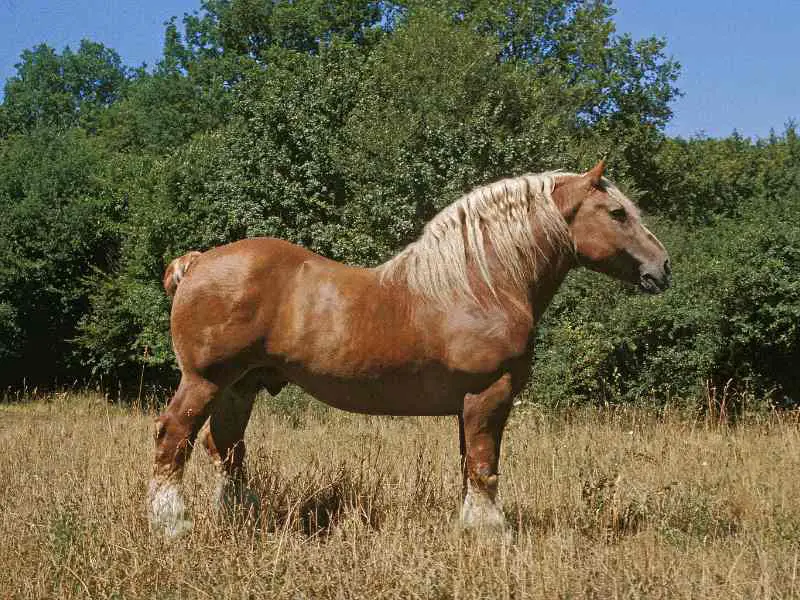
The Hispano-Bretón represents a Spanish draft horse breed that emerged through the fusion of Spanish and Breton horses. Exhibiting immense strength, a muscular physique, and an exceptional work ethic, these horses are highly regarded. Hispano-Bretóns are renowned for their remarkable endurance, versatility, and inherently gentle nature.
Traditionally used for agricultural tasks, heavy hauling, and forestry work, Hispano-Bretóns have consistently demonstrated their reliability and resilience as working horses. Their remarkable strength, combined with their calm temperament, makes them invaluable in various settings. Despite their imposing stature, they possess an inherent gentleness and a natural inclination to form strong bonds with their handlers.
Related: Why Can’t Horses Feel Their Mane
Summary of the Best Spanish Horse Breeds
In conclusion, the world of Spanish horse breeds is a tapestry woven with history, versatility, and beauty. From the regal Andalusian to the rugged Asturcón, each breed carries the legacy of centuries past and represents the unique regions from which they originate. Whether your heart belongs to the elegant Purebred Spanish Horse or the agile Pura Raza Mallorquina, these breeds stand as living testaments to Spain’s rich equestrian culture. As you explore the possibilities they offer, may you find inspiration in their strength, grace, and enduring connection to the heritage of Spain.
| Breed | Color | Size | Weight | Diet | Distinguishing Features |
| Andalusian Horse | Various colors | 15 to 16.2 hands | 1,000 to 1,200 kilograms | High-quality forage, supplemented with grain | Arched neck, well-muscled body, expressive eyes |
| Lusitano | Various colors | 15 to 16.2 hands | 1,000 to 1,200 kilograms | High-quality forage, supplemented with grains and vitamins | Well-defined musculature, intelligent expression, strong hindquarters |
| Menorquín | Primarily black | 14.1 to 15.2 hands | 400 to 500 kilograms | High-quality forage, supplemented with grains and vitamins | Compact build, strong legs, high-stepping movements |
| Asturcón | Bay, chestnut, or black | 11 to 12 hands | 250 to 300 kilograms | Grazing on mountain pastures | Compact build, thick mane and tail, gentle temperament |
| Pottok | Various colors | 11.2 to 13.2 hands | 200 to 250 kilograms | Grazing on native grasses | Compact build, thick mane and tail, hardy nature |
| Galician Pony | Various colors | 11 to 13 hands | 200 to 300 kilograms | Grazing on natural vegetation | Sturdy build, thick mane and tail, friendly disposition |
| Serrano | Bay, chestnut, or gray | 14.2 to 15.2 hands | 400 to 500 kilograms | Grazing on mountain pastures | Sturdy build, surefootedness, gentle temperament |
| Burguete Horse | Gray or bay | 15.2 to 16.2 hands | 550 to 600 kilograms | High-quality hay, grains, and pasture | Elegant appearance, docile temperament, strong build |
| Hispano-Bretón | Usually bay or chestnut | 15 to 16.2 hands | 700 to 800 kilograms | Balanced diet | Powerful build, strong muscles, gentle nature |
Frequently Asked Questions (FAQs)
While some Spanish horse breeds can be suitable for beginners due to their gentle temperament and trainability. Experts always recommend seeking guidance from experienced trainers or instructors before embarking on horse ownership or riding.
Yes, many Spanish horse breeds, such as the Andalusian and Lusitano, have demonstrated remarkable success in various competitive equestrian disciplines, including dressage, show jumping, and driving.
Some Spanish horse breeds, like the Pottok and Galician Pony, are known for their friendly nature and make excellent choices for children. However, parental supervision and proper training are crucial when introducing children to horses.
To learn more about Spanish horse breeds and their conservation efforts, you can visit reputable equestrian websites, consult breed-specific associations, or even plan a visit to Spain to experience these magnificent breeds firsthand.

